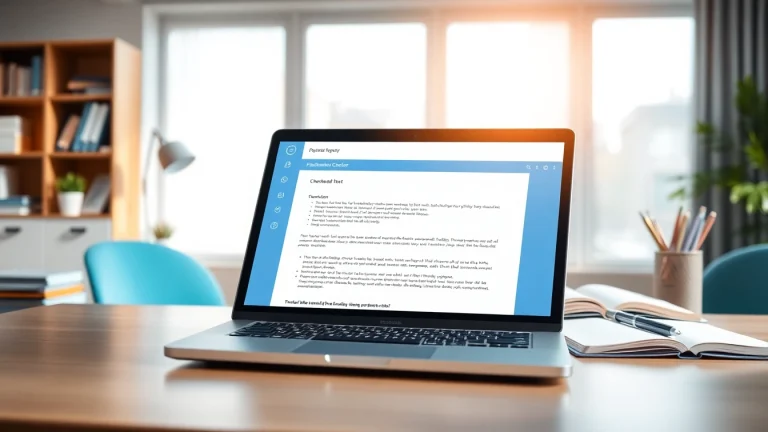
Why a Reliable Plagiarism Checker is Essential for Your Writing
Understanding Plagiarism and Its Consequences
Plagiarism has become a prevalent issue in academia and content creation, where ideas are often borrowed without proper attribution. As we navigate through various domains of life, understanding what constitutes plagiarism is crucial. Not only does plagiarism undermine the credibility of the individual involved, but it also has far-reaching consequences in the academic and professional world. A reliable plagiarism checker can serve as an invaluable tool in ensuring originality in written work.
1. Definition and Types of Plagiarism
Plagiarism is the act of presenting someone else’s ideas, words, or work as one’s own without proper acknowledgment. It can take various forms: copying text verbatim, paraphrasing without credit, and self-plagiarism, where an individual reuses their previous work without citation. Understanding these distinctions is important in fostering ethical writing practices.
- Verbal Plagiarism: Word-for-word copying of someone else’s ideas or content.
- Paraphrasing Plagiarism: Rewriting someone else’s ideas in one’s own words without giving credit.
- Self-Plagiarism: Resubmitting one’s own previous work without acknowledgment.
2. Academic and Professional Ramifications
The implications of plagiarism extend beyond mere academic failure. Students caught engaging in such practices may face disciplinary actions, which could range from failing grades to expulsion from institutions. For professionals, allegations of plagiarism can lead to loss of job opportunities, reputational damage, and even legal ramifications.
Moreover, organizations and academic institutions often uphold strict policies on originality, which are enforced to maintain standards of integrity. The importance of complying with these standards cannot be overstated as they contribute to a culture of accountability and respect for intellectual property.
3. How a Plagiarism Checker Can Help
A plagiarism checker acts as a preliminary filter that scans written content for any instances of potential plagiarism. Utilizing such a tool can save writers substantial amounts of time in the editing process and help in maintaining ethical writing standards. It can assist in:
- Identifying unintentional plagiarism before submission.
- Offering suggestions for proper citations and paraphrasing techniques.
- Enhancing overall writing quality by ensuring originality.
Key Features to Look for in a Plagiarism Checker
Selecting the right plagiarism checker is vital for ensuring its effectiveness. Various features can enhance your experience and reliability of the tool. Here are some essential features that one should consider.
1. Accuracy and Database Size
The effectiveness of a plagiarism checker greatly depends on its accuracy as well as the size of its database. A comprehensive database allows the checker to compare and identify instances of plagiarism more effectively. Reliable checkers compare content against academic journals, online articles, and student submissions, thereby ensuring robust plagiarism detection.
2. User-Friendly Interface
An intuitive interface is essential to ensure a smooth user experience. A good plagiarism checker should provide an easy navigation system, allowing users to upload documents and receive results instantly without unnecessary complications. The results should also be easy to read and interpret.
3. Additional Writing Tools Integration
Some plagiarism checkers offer integration with other writing tools, such as grammar checkers or formatting software. This feature enables a holistic approach to writing, where writers can edit grammar, check for plagiarism, and format references all in one place, resulting in a more efficient writing process.
How to Effectively Use a Plagiarism Checker
Using a plagiarism checker involves a multi-step process to ensure that your work is original and free from potential plagiarism.
1. Step-by-Step Guide to Checking Your Work
Follow these steps to effectively utilize a plagiarism checker:
- Select Your Document: Choose the document you wish to analyze for originality.
- Upload the Document: Use the plagiarism checker’s interface to upload the file or copy and paste your text.
- Run the Check: Initiate the plagiarism scan, allowing the tool to compare your text against its database.
- Review the Report: Analyze the results provided in the report, which may indicate matches, similarities, and suggestions for corrections.
2. Interpreting Results and Reports
Understanding the outcome of a plagiarism check is crucial. Typically, a plagiarism report will highlight sections of text that match other sources and provide links to the original work. A similarity percentage is often displayed to indicate how much of the text overlaps with existing material.
It’s essential to differentiate between acceptable common phrases and actual plagiarism. The report might also suggest ways to paraphrase or cite correctly to avoid any issues. Thus, a thoughtful interpretation can lead to significant enhancements in writing quality.
3. Making Corrections to Ensure Originality
After interpreting the report, writers should take actionable steps to make necessary corrections. This can involve:
- Paraphrasing sections of text that show high similarity.
- Incorporating citations for any borrowed ideas or phrases.
- Revising content to enhance originality and reduce overlap.
Common Challenges Faced When Using Plagiarism Checkers
While plagiarism checkers are helpful tools, users may encounter various challenges in utilizing them effectively.
1. Over-Reliance on Technology
One common challenge is the overly reliance on these tools to ensure originality. While a plagiarism checker can detect similarities, users must also engage in critical thinking to evaluate their work. Writers should not solely depend on technology but should develop their skills in citation and originality.
2. Misunderstanding of Results
Due to the complexity of plagiarism checks, there may be misunderstandings regarding the results. A percentage of similarity does not always imply plagiarism, as it often includes common phrases and terminologies. Therefore, users should take the time to comprehend the results and what they genuinely indicate about their writing.
3. Cost Considerations for Premium Services
Many plagiarism checkers offer limited free services, with more advanced features available through paid plans. This can pose a challenge for students and writers on tight budgets. It’s crucial to find a balance between cost and quality when choosing a plagiarism checker, and to explore various options before committing to a premium service.
Future Trends in Plagiarism Detection
As technology continues to evolve, so too will the landscape of plagiarism detection. Being aware of emerging trends can help writers stay ahead in maintaining originality.
1. The Role of AI in Enhancing Detection Accuracy
The advent of artificial intelligence is revolutionizing plagiarism detection. AI algorithms are becoming increasingly sophisticated, allowing for more accurate and nuanced analysis of text. This can help in identifying not just direct copying but also underlying similarities in structure and ideas.
2. Evolving Standards in Academic Integrity
As academic institutions adapt to the changing landscape of information sharing, standards regarding plagiarism and originality are also evolving. There is a growing emphasis on educating students about academic integrity and the ethical implications of plagiarism. This shift is likely to influence the design and functionality of plagiarism detection tools.
3. Increasing Demand for Diverse Language Support
With the global rise of multilingual content, the demand for plagiarism checkers that support diverse languages is increasing. Developers are likely to create more sophisticated tools that can detect plagiarism in various languages, catering to the needs of a wider audience and enhancing the accessibility of safe writing practices.


